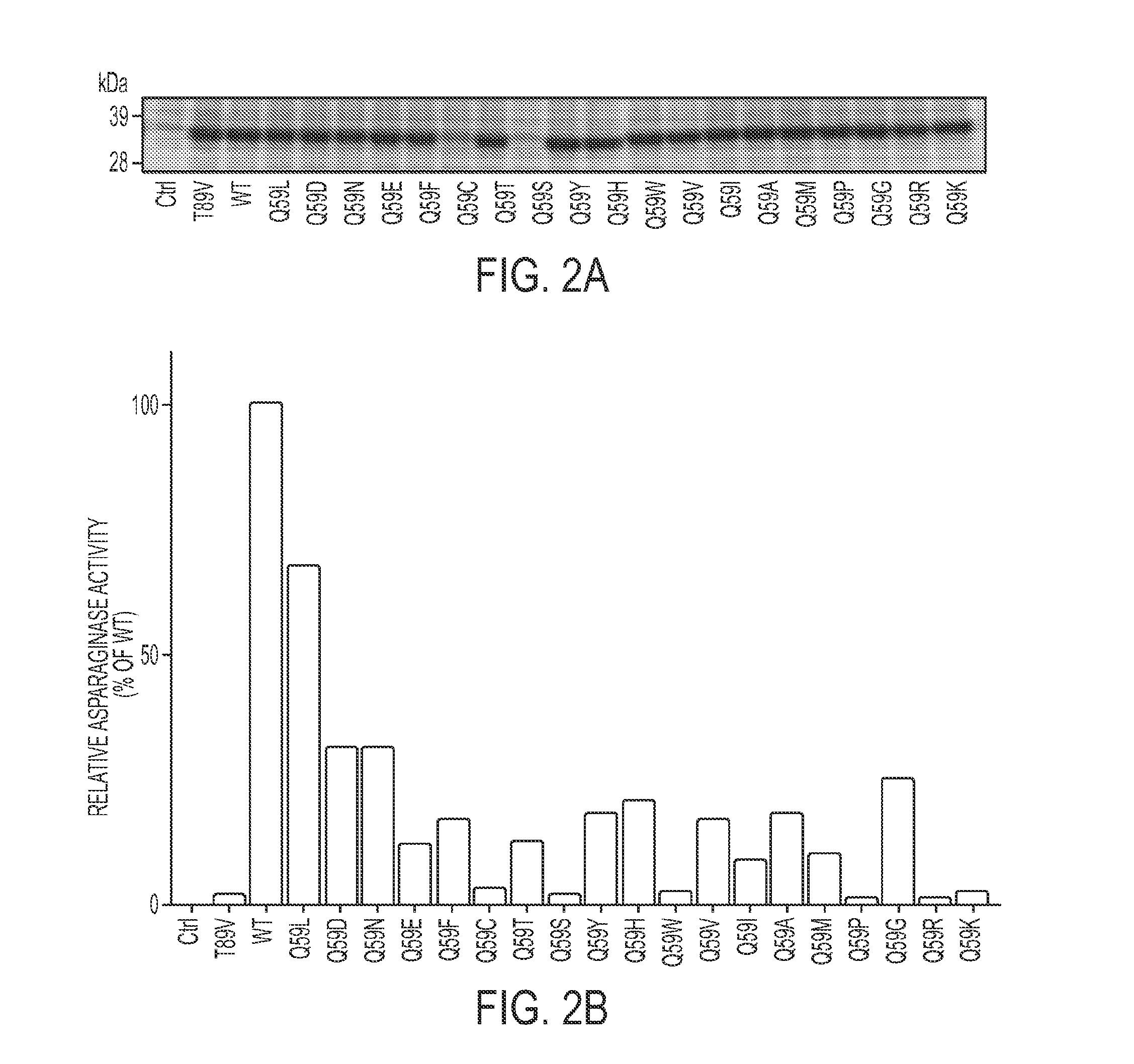Therapeutic asparaginases
a technology of asparaginase and therapeutic asparaginase, which is applied in the field of cancer treatment with enzymes, can solve the problems of poor outcome, limited l-asp therapy, and known whether the therapeutic index of l-asp would be increased, and achieve the effect of increasing the in vivo half-life and increasing serum stability
- Summary
- Abstract
- Description
- Claims
- Application Information
AI Technical Summary
Benefits of technology
Problems solved by technology
Method used
Image
Examples
example 1
Materials & Methods
[0197]Molecular Dynamics Simulations.
[0198]The crystal structure of E. coli L-ASN type II (PDB ID 1NNS) was used as a template for molecular simulations. In this structure, the preferred product, aspartic acid, occupies the catalytic site. Simulations included all residues (1-326) resolved in the crystal structures. Molecular transformations, assembly of the simulation cells, computational analysis of the results, and visualization were done using publicly available and custom-written scripts in Visual Molecular Dynamic (VMD) 1.8 (Humphrey et al., 1996). The substrate molecules (asparagine, glutamine) were derived from aspartic acid using the PSFGEN plugin for VMD to preserve the coordinates of the backbone and identical atoms. The N- and C-termini of INNS were modeled in the charged state. For the remaining amino acid residues, the dissociation state was estimated using ProPka (on the world wide web at propka.ki.ku.dk / ) and found to be in the default state at a n...
example 2
Molecular Dynamics of L-ASP
[0219]To guide mutagenesis experiments aimed at creating a glutaminase-deficient mutant, 20-ns MD simulations of WT L-ASP bound with asparagine or glutamine were performed. Preferential orientations and contacts of the two substrates within the lining of the L-ASP catalytic cleft were compared and critical differences in how each substrate is coordinated were identified. Analysis of enzyme-substrate contact times served as a basis for identifying the most promising mutagenesis target.
[0220]Both substrates changed positions within ˜200 to 300 ps compared with the crystallographic orientation of aspartate. That re-orientation occurred in all four enzyme-binding pockets of the tetramer, clearly establishing a different preference for asparagine and glutamine compared with the product, aspartate. The re-orientation could be attributed to the fact that both substrates include uncharged amide side chains rather than the negatively charged carboxylate moiety of t...
example 3
Characterization of L-ASP Q59 Mutants
[0224]Site-directed mutagenesis was performed to obtain Q59 variants of the enzyme. L-ASP expression vectors, coding for all 20 possible amino acids at position 59, were transformed into E. coli BL-21. All mutants except Q59C and Q59S were expressed and secreted into the culture medium as efficiently as the WT protein (FIG. 2A). Subsequent kinetic screening using colorimetric assays indicated that the mutants exhibited a spectrum of asparaginase activity ranging from 0% to 80% of WT, with a median of 12% (FIG. 2B). The Q59 mutants also exhibited a spectrum of glutaminase activity ranging from 0% to 60% of WT, but the median was just 2% of WT glutaminase activity (FIG. 2C), suggesting that Q59 is indeed more important for glutaminase activity than for asparaginase activity.
[0225]To exclude the possibility that endogenous E. coli L-ASP was contributing to the asparaginase and glutaminase activities measured on non-purified supernatants, the Q59L, Q...
PUM
 Login to View More
Login to View More Abstract
Description
Claims
Application Information
 Login to View More
Login to View More - R&D
- Intellectual Property
- Life Sciences
- Materials
- Tech Scout
- Unparalleled Data Quality
- Higher Quality Content
- 60% Fewer Hallucinations
Browse by: Latest US Patents, China's latest patents, Technical Efficacy Thesaurus, Application Domain, Technology Topic, Popular Technical Reports.
© 2025 PatSnap. All rights reserved.Legal|Privacy policy|Modern Slavery Act Transparency Statement|Sitemap|About US| Contact US: help@patsnap.com



